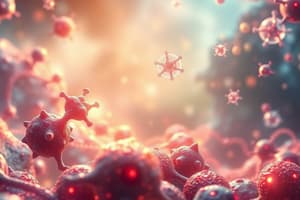Podcast
Questions and Answers
What structure refers to the arrangement of multiple polypeptide chains in a protein?
What structure refers to the arrangement of multiple polypeptide chains in a protein?
- Tertiary structure
- Secondary structure
- Primary structure
- Quaternary structure (correct)
All enzymes are nucleic acids.
All enzymes are nucleic acids.
False (B)
What forms the structural backbone of DNA and RNA?
What forms the structural backbone of DNA and RNA?
Nucleotides
The molecule that is primarily responsible for carrying genetic information in most organisms is called _____.
The molecule that is primarily responsible for carrying genetic information in most organisms is called _____.
Match the following components with their descriptions:
Match the following components with their descriptions:
What are carbohydrates primarily used for in living organisms?
What are carbohydrates primarily used for in living organisms?
All lipids are hydrophilic molecules.
All lipids are hydrophilic molecules.
What is the role of phospholipids in cells?
What is the role of phospholipids in cells?
The basic building blocks of carbohydrates are __________.
The basic building blocks of carbohydrates are __________.
Which of the following statements about proteins is true?
Which of the following statements about proteins is true?
Match the type of carbohydrate with its description:
Match the type of carbohydrate with its description:
Saturated fats contain one or more double bonds between carbon atoms.
Saturated fats contain one or more double bonds between carbon atoms.
Name one role of lipids in living organisms.
Name one role of lipids in living organisms.
Flashcards
Quaternary Structure
Quaternary Structure
The overall 3D shape formed by the arrangement of multiple polypeptide chains in a protein.
Nucleic Acid Functions
Nucleic Acid Functions
DNA stores and transmits genetic information, while RNA plays roles in protein synthesis and gene regulation.
Nucleotide
Nucleotide
The building block of DNA and RNA, consisting of a sugar, phosphate group, and nitrogenous base.
Enzyme Function
Enzyme Function
Signup and view all the flashcards
Active Site
Active Site
Signup and view all the flashcards
What is Biochemistry?
What is Biochemistry?
Signup and view all the flashcards
What is a monosaccharide?
What is a monosaccharide?
Signup and view all the flashcards
What are lipids?
What are lipids?
Signup and view all the flashcards
What is the primary structure of a protein?
What is the primary structure of a protein?
Signup and view all the flashcards
What is a polysaccharide?
What is a polysaccharide?
Signup and view all the flashcards
What is the tertiary structure of a protein?
What is the tertiary structure of a protein?
Signup and view all the flashcards
What are amino acids?
What are amino acids?
Signup and view all the flashcards
What is catabolism?
What is catabolism?
Signup and view all the flashcards
Study Notes
Introduction to Biochemistry
- Biochemistry is the study of chemical processes within and relating to living organisms.
- It encompasses a wide range of topics, including the structure and function of biological molecules, metabolism, and the regulation of biochemical pathways.
- Key biological molecules include carbohydrates, lipids, proteins, and nucleic acids.
- These molecules are essential for various life processes, including energy production, cell signaling, and genetic information transmission.
Carbohydrates
- Carbohydrates are the primary source of energy for most organisms.
- They are composed of carbon, hydrogen, and oxygen atoms.
- Simple sugars (monosaccharides) are the basic building blocks of carbohydrates.
- Common monosaccharides include glucose, fructose, and galactose.
- Disaccharides are formed by the condensation of two monosaccharides. Sucrose, lactose, and maltose are examples.
- Polysaccharides are long chains of monosaccharides. Starch and glycogen are energy storage polysaccharides, while cellulose is a structural polysaccharide.
- Carbohydrates play a crucial role in cell recognition and structure.
Lipids
- Lipids are a diverse group of hydrophobic molecules, including fats, oils, and waxes.
- They are primarily composed of carbon and hydrogen atoms.
- Fats and oils are composed of fatty acids and glycerol.
- Fatty acids can be saturated or unsaturated.
- Saturated fats contain only single bonds between carbon atoms, while unsaturated fats contain one or more double bonds.
- Phospholipids are a crucial component of cell membranes.
- Steroids, such as cholesterol, serve various functions within the body.
- Lipids play roles in hormone production, insulation, and energy storage.
Proteins
- Proteins are complex organic molecules composed of amino acids linked together by peptide bonds.
- Twenty different amino acids are common.
- The specific sequence and arrangement of amino acids determine the unique structure and function of each protein.
- Proteins play diverse roles in biological systems, including catalyzing reactions as enzymes, providing structural support, and regulating cellular processes.
- The four levels of protein structure are primary, secondary, tertiary, and quaternary.
- Primary structure is the linear sequence of amino acids.
- Secondary structure involves local folding patterns, such as alpha-helices and beta-sheets.
- Tertiary structure is the overall three-dimensional shape of a protein.
- Quaternary structure is the arrangement of multiple polypeptide chains in a protein.
- Protein function is directly determined by its three-dimensional structure.
Nucleic Acids
- Nucleic acids, DNA and RNA, store and transmit genetic information.
- DNA (deoxyribonucleic acid) is the primary genetic material in most organisms.
- RNA (ribonucleic acid) plays several roles in protein synthesis and gene regulation.
- Both DNA and RNA are composed of nucleotides.
- Nucleotides each consist of a sugar, a phosphate group, and a nitrogenous base.
- DNA is a double helix structure, while RNA is typically single-stranded.
- Nucleic acids are essential for inheritance and protein synthesis.
Enzymes
- Enzymes are biological catalysts that speed up chemical reactions in living organisms.
- Most enzymes are proteins.
- Enzymes lower the activation energy required for a reaction to occur.
- The active site of an enzyme is where the substrate binds.
- Enzyme activity is affected by factors such as temperature, pH, and substrate concentration.
- Enzymes are highly specific for their substrates.
Studying That Suits You
Use AI to generate personalized quizzes and flashcards to suit your learning preferences.




